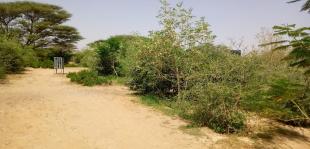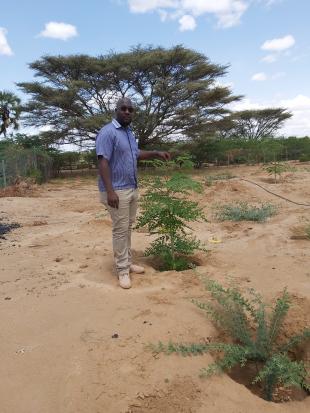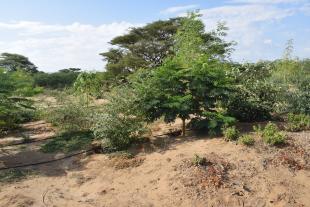Planting a mini-forest in Turkana
Survival of human populations in hot Arid and Semi-Arid Lands (ASAL) is a challenge, with desertification in particular being associated with loss of tree cover. When reforestation is attempted, the heat and the lack of water also results in very poor survival rates of the tree saplings. To make matters worse, brackish or saline water is often the only water that is available in hot and arid places, but it is unfit for consumption not just by people and livestock, but also by most plants, and in the long run it will degrade soils to the point of making them unproductive. But could that water be turned into a valuable resource for agroforestry and reforestation?
In June 2020, our partner KEFRI conducted an irrigation experiment in Nadapal sublocation, Naurienpuu, Turkana County, Kenya as part of our GCRF/Scottish Funding Council-funded project “Novel desalination and irrigation techniques tailored for poor rural communities in Arid and Semi-Arid Land areas”. We compared three methods of irrigation for the maintenance and growth of tree samplings of species that were selected by the community:
- Traditional, simply pouring water on the soil around the sapling. Cheap but inefficient and not suited for brackish/saline water.
- Modern, using drip-feed irrigation. Efficient but expensive and not suited to brackish or saline water.
- Adapted, consisting in our innovative approach for the use of brackish or saline water that shields the soil and the plants. It is also very cheap (full detail here)
At the beginning of the experiment we planted a total of 216 trees, evenly distributed between eight different species, three different soil treatments and the three methods of irrigation that were previously mentioned. Therefore, each combination of tree species, irrigation methods and soil treatment was in triplicate. We then monitored the growth of the tree saplings over 6 months.
The mini-forest that we planted as a result was a success. It clearly demonstrated that our adapted method enabled survival and even growth of tree saplings, thus offering the promise of allowing the use of brakish water for agroforestry and reforestation. As an aside, the plantation has since become a bit of a local attraction, providing its visitors with relief from the baking heat and harsh sunshine.





